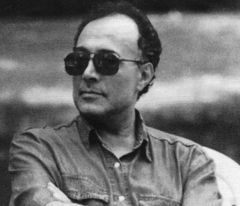
TIFF Cinematheque Presents - The Films of Abbas Kiarostami
Beginning February 25 and ending April 3, TIFF Cinematheque presents a series of films by Iranian Master Abbas Kiarostami. Kiarostami is one of the most influential Iranian filmmakers who definitely put Iran on the filmmaking map.
Kiarostami is one of the few directors to remain in Iran after the 1979 revolution. He claims that if a tree is uprooted it cannot bear as good a fruit as when it was in its original place. True to his word, his best films are set in Iran and these demonstrate and reveal true Iranian mores and culture. He made two film in Japan (LIKE SOMEONE I LOVE) and France (CERTIFIED COPY), both of which I am the least fond of.
It is TIFF and the Aga Khan Museum that have partnered to co-present The Wind Will Carry Us: The Films of Abbas Kiarostami and Seeing Beyond the Visible: The Films of Abbas Kiarostami.
For the complete program, ticket pricing and venue, check the TIFF website at:
The Programmer’s Essay on the Kiarostami Program written by Senior Programmer at TIFF, James Quandt is reproduced here courtesy of TIFF.
"We are living in the era of Kiarostami, but don't yet know it." — Werner Herzog
"Kiarostami represents the highest level of artistry in the cinema." — Martin Scorsese
"One of the giants of contemporary world cinema." — Jonathan Rosenbaum
Just as there are painters' painters, so there are directors' directors, and Abbas Kiarostami is supreme amongst this cinematic elite. Perhaps more than any other contemporary filmmaker, the Iranian auteur has earned the esteem of his fellow artists, his avid admirers ranging from the cerebral and confrontational (Michael Haneke) to the poetic and political (Chris Marker). In a rare homage, Japanese sensei Akira Kurosawa declared that "The films of Abbas Kiarostami are extraordinary. Words cannot describe my feelings about them and I simply advise you to see his films.... When Satyajit Ray passed on, I was very depressed. But after seeing Kiarostami's films, I thanked God for giving us just the right person to take his place."
The parallel between Kiarostami and Ray is apt, in ways both overt and inadvertent. Both directors owe a great debt to Italian neorealism, especially the films of Vittorio De Sica (screened this past summer at the Cinematheque). Such early Kiarostami films as The Experience and The Traveler invoke the classic humanism of Bicycle Thieves, and even as his aesthetic became increasingly sophisticated, Kiarostami continued to summon the spirit of De Sica by shooting on location and using non-professional actors in his attempt to capture what he called "naked reality." Both Kiarostami and Ray are polymaths, their gifts extending to many other arts, and both incorporate their nation's poetry into their films. Kiarostami shared Ray's background in visual design, having studied painting and graphics at Tehran University before embarking on a career in advertising, which was Ray's initial vocation as well (as unlikely as that seems for two such resolutely non-commercial artists). And like Ray, who helped lay the groundwork for the Bengali art cinema when he founded the Calcutta Film Society in 1947, Kiarostami made a critical contribution to the emergence of the Iranian New Wave when he helped establish a film unit at Tehran's Institute for the Intellectual Development of Children and Young Adults. Beginning in 1970, he produced a series of internationally acclaimed short films and features, some fictional, some documentary, invariably about the world of infants and adolescents, many of which recall Ray's celebrated Apu Trilogy in theme and approach.
Just as Ray has long been subject to a series of critical platitudes — about his humanism and universality, his literary inclinations, his Chekhovian subtlety and the contemplative serenity and simplicity of his style — which conveniently exclude the many contending factors in his work (e.g., modernism, politics, the occult), Kiarostami remained burdened with his early reputation as a neorealist even as his films grew increasingly formalist, complex, and pessimistic. Kiarostami's began as a cinema of poetic humanism and deceptive simplicity, an art that wrested moments of grace from the midst of privation and devastation; as one critic remarked, "This is Kiarostami's art: to show that the world is (still) livably beautiful." But in the grid-like repetitions of such early films as Fellow Citizen and Orderly or Disorderly, one can already discern a measure of structuralist rigour that portended later experimentation.
With the startling incursions of fiction into documentary and vice versa in Close-Up, Kiarostami singlehandedly established a genre that one might call "Persian meta." (Jafar Panahi's Taxi is only the most recent example of this approach.) The film recreates a true story Kiarostami read in a magazine, about an imposter who was exposed by one of his "victims" and charged with impersonation; that the man was posing as one of Iran's other leading directors, Mohsen Makhmalbaf, is just the first of Close-Up's many chutes-and-ladders ironies. Recruiting the actual participants in the case to re-enact their experiences, Kiarostami is not content to explore the difference between cinema and reality: as the film proceeds, fiction and documentary become hopelessly intertwined, until, in the formalist coup that resolves the film, the director erases the line between captured and staged actuality. ("My ideal is to reach fiction through the documentary," he has said.)
Similarly, in the so-called Koker Trilogy that made his international reputation (comprised of Where is the Friend's Home?, And Life Goes On, and Through the Olive Trees) and the much-debated, free-form video coda of Taste of Cherry, Kiarostami toys with the correlations between actuality and fiction through a variety of means: he often has his non-professional actors play roles identical to their real-life selves, while using actors to represent himself; he incorporates the making of the film into the narrative, even as the film itself transforms into something far different than what we see being made. But these strategies (and others, such as Kiarostami's use of protracted takes — heart-stoppingly deployed at the end of And Life Goes On — and repetition of sequences) are directed toward a profoundly humanist, not merely formalist, end. "Adults, like children, have this problem of not understanding each other," Kiarostami says in explaining his purpose. "I like dealing with such subjects, to show the misunderstanding from all sides and to create relationships."
Even as the films after the Koker Trilogy continued the director's peripatetic tendencies (Kiarostami shares with this season's other major auteur, Wim Wenders, a propensity for the road movie), the bleak ambiguities and locked shots of Taste of Cherry and the radical ellipses and reiterations of The Wind Will Carry Us signalled a shift towards a more traditional modernism, as if Kiarostami had imbibed the austerity and asperity of late Bresson. (Kiarostami greatly admires the French master, and indeed Taste of Cherry could profitably be double-billed with Bresson's Le Diable probablement, both films depicting journeys in search of suicide.) Though the transporting allegory of Wind appears to reaffirm the humanist-existentialist gist of Kiarostami's vision, its inversion of the cosmology of heaven and earth — ascent associated with duplicity and death, descent with authenticity and life — is as brave and strange as the protagonist's quest for oblivion in Taste of Cherry, which had breached the humanist tenets of the director's previous cinema.
As with Bresson, Kiarostami undertook a process of aesthetic paring (or what the French evocatively call dépouillement, with its connotations of denuding) as his career progressed. Digital filmmaking allowed Kiarostami to work in a more solitary and unencumbered manner, so that he could produce films without (or so he averred) capital, censorship, or control. The attenuations and obstinate focus on the supposedly inconsequential in films like Five and Ten ("I like those seemingly unimportant shots more than the important ones," Kiarostami recently told a class at Indiana University) might have challenged audiences more accustomed to the director's neorealist lyricism, but this phase produced more than one masterwork. Ten, for instance, initially seems ostentatiously spare — an ambulatory confessional without close-ups, little cross-cutting, and no music (until the end credits) — but beneath its minimal, matter-of-fact surface lies a minefield of mysteries.
Emerging from this period of asceticism, Kiarostami surprised us yet again by contravening his edict that he would never leave Iran and going to Tuscany and Japan to make international co-productions on comparatively larger budgets, one of them with a major international star in Juliette Binoche. Metaphorically as well, both Certified Copy and Like Someone in Love appear like departures for Kiarostami: Copy seems to draw on the high-modernist lineage of Antonioni, Rossellini and Resnais, while Someone sometimes exhibits the urban nocturnal sheen and narrative obliquity of Wong Kar-wai or late Hou, and portrays a violence hitherto foreign to Kiarostami's films. But in the former's meta contemplation of artistic creation and the latter's elliptical unfolding (not to mention that both are "road movies" of a sort!), Kiarostami's themes and manner forcefully emerge. Take, for instance, the opening sequences of both films, in which offscreen sound radically challenges us to puzzle out the various relationships — spatial, sonic, familial, amorous. One thinks of Kiarostami's recent advice to students:
There are many spatial dimensions, but when we watch a film, we're only seeing one of these dimensions: what's right in front of us. Offscreen sound reminds us of these other dimensions that we may not be able to bring up onscreen.... Offscreen sound is witness to the fact that, when we close our eyes, the world still goes on.
That latter phrase, which echoes the title of one of Kiarostami's most beloved films, also evokes the very premise of his cinema: the conviction that "life goes on" even amid planetary catastrophe, and even as the wind has carried the traveller far from home.
— James Quandt
CAPSULE REVIEWS OF SELECTED FILMS:
CERTIFIED COPY (COPIE CONFORME) (Iran/France 2010) **
Directed by Abbas Kiarostami

Kiarostami is known to be experimental in his art of film making. He goes past limits in CERTIFIED COPY by blending in the imaginary with reality. The lead characters of the story are British writer James Miller (William Shimell) and an antiques dealer, known only as ‘she’ (Juliette Binoche). At the film start, she wishes to meet him personally and wishes quietly that they might form a couple. As the film progresses, Kiarostami erases this line. The couple evolves into a married bickering pair by the last third of the film. The tactic may be novel, but it does not really work, especially when one is expected to feel for a couple whose relationship could be imaginary. Kiarostami also attempts to understand the French people and the way they think, eat, drink and make love. When making films in his own country Iran, and dealing with what he knows, his films are believable and touching whereas CERTIFIED COPY feels pretentious and false. Too bad, as the lead performances are quite good. Binoche won the Best Actress Award at Cannes where the tim premiered.
(Screening April 10)
CLOSE-UP (Iran 1990) ****
Directed by Abbas Kiarostami

Hossain Sabzian a cinephile, and a big fan of popular Iranian director Mohsen Makhmalbaf pretends to be him to the Ahankhah family. He uses the family home for a shoot while hiring the sons s actors. But the father becomes suspicious and Sabzian is eventually arrested. Director Kiarostami films the proceedings that include the trail with all the real characters playing themselves, even with the judge at the trial. Mohsen Makhmalbaf and Kirosstami also appear in the film. It is a simple film called CLOSE -UP because the camera in the court room is a full close-up of Sabzian without any zooming capability. What makes this film so popular and respected among cinephiles is that Kiraostami blends in the Iranian people’s real life situations into the story. The poverty and honesty of the people, the unemployment problem, the compassion of the rich for the poor all tie to the outcome of Sabzian’s trial. Sabzian is depicted more as a victim of society than a criminal. He is at the end, given a second chance, which is the film’s happy ending with good triumphing over evil. Sight and Sound’s 2012 poll put CLOSE-UP at the top 50 films of all time. The film (also Kiraostami personal favourite) will be introduced by scholar Kaveh Askari who will also explore cinema and celebrity in Iran and how the success of reflexive documentary filmmaking came at a pivotal moment in the country’s cinematic history.
(Screening March 1st)
TASTE OF CHERRY (Iran 1997) **
Directed by Abbas Kiarostami

The film follows Mr. Badii (Homayon Ershadi), a middle-aged man, drives through Tehran looking for someone to do a job for him, and he offers a large amount of money in return. It is revealed that Badii plans to kill himself and has already dug the grave. He needs someone to throw earth on his body, after his death. He encounters various prospects including a soldier, a seminarist an a taxidermist. No reason is offered for the reason of his suicide. Mr. Badii could have hired many others as he drives through a crowd looking for work at the film’s start. The film consists of shots of Mr. Badii in the car and out showing much of a barren countryside of brown and hills. This incredibly boring art film just meanders on and on with this indecisive character. The film builds to the climax on whether Baddii will die at the end. It does not help help that the film ends with Kirasostami revealing himself and his crew shooting this film. The film received mixed reviews but it did win the Palme d’Or at Cannes. The late American critic Roger Ebert hated the film crowning it with one star.
(Screening: March 11)
TEN (Iran/France 2002) ***1/2
Directed by Abbas Kiarostami

Like TASTE OF CHERRY, TEN is shot entirely within the front seat of a car navigating the streets of Tehran. The audience only sees the passenger or the driver but hardly ever both together. TEN is a minimalist film but reveals a lot about Iranian culture without being too prenentious, unlike TASTE OF CHERRY. The lead character is the driver, a pretty modern divorcee (Mania Akbari) who drive a variety of passengers. My favourite segment is the first with her driving her mouthy young son, The boy is clever enough to know what his mother thinks and is not afraid to say whatever it takes to put her in place. The segment is hilarious, subtle and keenly observative. The kid actor plaint the boys is nothing short of marvellous. The other passengers include a debut old woman and a prostitute. The film is called TEN because it record a total of the encounters between the driver and the assorted passengers.
(Screening march 1)
THE WIND WILL CARRY US (Iran 1999) ***
Directed by Abbas Kiarostami

Highlighted as a masterpiece by many critics and winner of many awards including the Silver Bear and Golden Lion at the Venice Film Festival, THE WIND WILL CARRY US (the words coming from an Iranian poem) is a movie that goes nowhere and is about nothing and everything from life to death to barrenness to beauty. It is an art-house film that requires patience but to many, the patience will be rewarded, depending on the individual, of course. When the film opens, Behzad, Keyvan, Ali and Jahan, three journalists visit a remote Kurdish village. But they pretend to be production engineers in order to document the locals' mourning rituals that anticipate the death of an old woman, but she remains alive. The main engineer is forced to slow down and appreciate the lifestyle of the village, especially in he segment in which he enters a cellar to buy milk that he carries in a borrowed bowl.
(Screening: March 22)



Comments powered by CComment